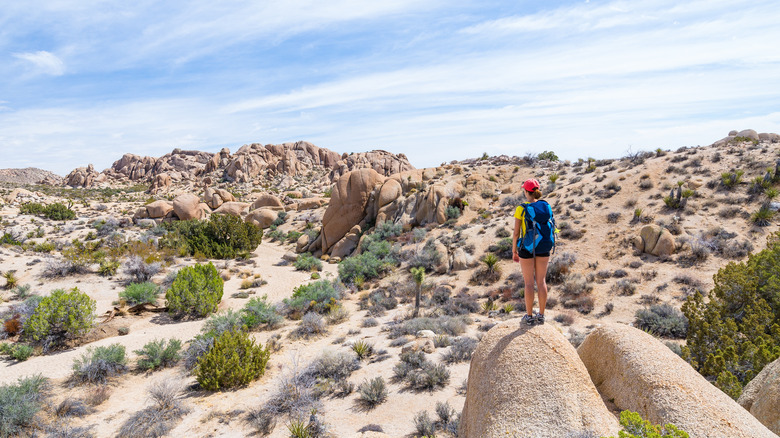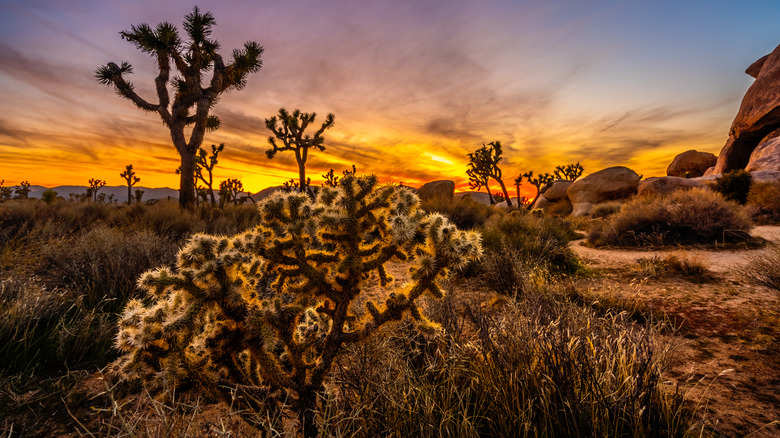Joshua Tree National Park is one of the most popular destinations in Southern California, and it’s only getting more popular each year. According to statistics from the National Park Service, a record-breaking 3,282,575 visitors spent time in the park in 2023, up 7% from 2022. However, more visitors can come with more accidents and injuries, and we don’t just mean dehydration from the dry desert air or a scary run-in with a coyote.
One TikToker who goes by @love_lang_liz posted a carousel of photos documenting her experience with one of Joshua Tree’s hidden dangers: prickly cacti. In two of the snaps, a portion of a cholla cactus (also known as a “jumping cholla”) is seen attached to the content creator’s hand, leading her to visit the hospital for emergency care.
The cacti are the main attraction of Joshua Tree’s Cholla Cactus Garden, an area boasting 10 acres of teddybear cholla cacti. The walking trail through the garden is an ideal spot for selfies, but it’s important to not get too close to the plants — otherwise, you might suffer a painful poke to your skin.
How dangerous are the cacti in Joshua Tree?
In response to @love_lang_liz’s photos, some TikTok users were skeptical of how dangerous the cholla cacti in Joshua Tree National Park could really be. “Going to the ER to get a cactus off your hand is giving wealthy [sic] and insane,” reads one popular comment. “Questions to ask yourself before going to the ER: is it an emergency?” quipped another commenter.
However, getting pricked by the spines of a cholla cactus can be more than just an uncomfortable ordeal. According to a 2018 study published in Proceedings of the Royal Society B, cholla thorns latch deep into the skin of any animal (or human) that brushes against them and are more difficult to remove than other types of cactus spines. In fact, the study’s researchers discovered that just one cholla thorn is enough to grab onto and lift a half-pound piece of meat. Needless to say, you might be better off not ripping a stubborn spine out of your skin yourself.
In 2018, Lyle Odelein, a former professional hockey player, got pricked by a cholla cactus in Arizona and, with the help of his friends and a golf club, dislodged the plant from his leg. Unfortunately, the seemingly harmless injury developed into a serious case of blood poisoning, damaging Odelein’s heart and causing kidney and liver failure. Though he survived, his story is a reminder of just how treacherous a simple cactus prick can be.
How to protect yourself

A bloody puncture from a cactus isn’t the kind of souvenir you want to bring home from your Joshua Tree trip. To keep yourself safe, be sure to pack a first-aid kit along with your standard gear for a day at the national park. The National Park Service suggests packing a comb and tape in your kit to remove hair-like cactus spines, though you might also want to bring tweezers and pliers for thicker thorns.
If you do get spiked while visiting the park, remove the spine quickly but carefully, as emergency medicine physician Dr. Faried Banimahd suggested to the Los Angeles Times. “You start to have a reaction around the spine and you start to get tissue around it, and it’s harder to get out [if you wait],” he explained. Pull straight out but not in the direction of your face or another person.
Once the piece is removed, wash your hands and the affected area with water (and soap, if available). If you struggle to remove the spine or notice a rash or any other concerning symptoms, promptly seek medical attention. Before leaving Joshua Tree, check your clothing, bags, and shoes for any additional spikes, and use gloves or the tape in your first-aid kit to carefully remove the barbs.

